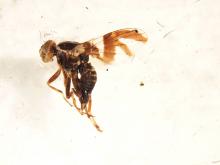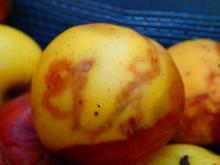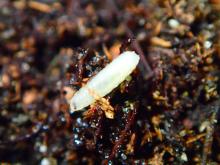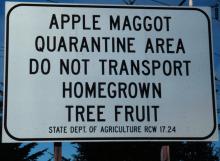Rhagoletis pomonella
The apple maggot is a small fly native to the northeastern United States and Canada, where it originally fed on hawthorn. It was not until 100 years after apples were introduced to North America that it was found feeding on apples. Today, it is a key pest of apples in northeastern regions, where several insecticide sprays are necessary to produce fruit free from maggot injury and contamination. It has since migrated to the PNW, where it was originally found in Portland in 1979. By 2000, it was found in most western Oregon and Washington counties, where it is a very destructive pest. The apple maggot remains a threat to the commercial Northwest apple industry in the Columbia River Basin. The maggots develop in apples, quince, and the fruits of native and ornamental hawthorn. The apple maggot also may occur incidentally in pear, plum, and tart cherry. Early cultivars of apples are particularly susceptible to damage. There is a quarantine on the movement of fruit from Washington and Oregon counties known to have this pest. Check with your State Department of Agriculture for details.
Pest description and crop damage The adult fly is about the size of a housefly. The body is black, and the abdomen has distinctive white bands. The wings are banded with black. The eyes of the adult fly are dull red. The larva is cylindrical, tapering to a pointed, non-distinct head, and is white except for two dark mouth hooks. The pupa appears similar to a large, dark brown grain of wheat. Eggs are small, white and smooth, but are rarely seen, as they are laid under the skin of host fruit.
Larvae tunnel through the fruit, leaving a brown, threadlike, irregular trail. Tunnels enlarge as the larvae grow. The tunnels serve as entry points for decay organisms, which cause internal rotting. Fruit of soft-fleshed, early maturing varieties often drop prematurely in response to damage. In hard-fleshed, late-maturing varieties, internal decay may not occur until after the apple drops.
Biology and life history The apple maggot spends the winter in the soil in the pupal stage. As the soil warms, it begins to develop, and in June, the adults begin to emerge. Emergence continues through the summer, and flies are active until October. Adults feed on honeydew produced by aphids or other insects, and after seven to ten days mate and lay eggs. Eggs are laid singly under the skin of an apple, causing a small, brown, decayed area to develop. Eggs hatch in two to ten days, and larvae commence tunneling through the fruit. Development is completed in twenty to thirty days, at which point the fruit often drops to the ground. Larvae then leave the fruit and burrow into the soil to pupate. There is usually only one generation per year.
Scouting and thresholds The most effective monitoring method involves the use of yellow or red sticky traps. Yellow sticky cards baited with ammonium carbonate chargers are effective (this same trap/lure combination is also used for the cherry fruit fly and the walnut husk fly). A red plastic sphere (mimicking an apple) covered with sticky glue is also effective and can also be enhanced with the charger. Hang traps in the outer third of the canopy by mid-June and inspect regularly. A phenology model for this pest can be used to predict the first emergence of flies (uspest.org). Traps can be used to verify emergence predictions from the model. Note that a low fly population may not be detected using the traps, so place the trap in a location where there is a history of activity or damage to obtain the best representation of emergence timing.
Management-biological control
Because the larvae are protected inside the apple fruit as they develop, little effective biological control has been observed. Larvae and pupae may suffer mortality from natural enemies such as nematodes and entomopathogenic fungi while they are in the soil.
Management-cultural control
Sanitation is one of the most effective management strategies for home orchards. Regularly inspect fruit while it is on the tree, removing and destroying any maggot-infested fruit. Destroy infested fruit on the ground, or the maggots will continue to develop and pupate in the soil. Pick up and destroy fallen apples at weekly intervals from early August until harvest. In home orchards, traps can be used to manage low density fly populations by trapping adults before they reproduce. Place one apple maggot trap in each small apple tree (less than 8 feet tall), two to four traps on medium-sized trees, or six to eight traps on trees 20 to 25 feet tall. Clean traps weekly and replace adhesive every 3 weeks. This technique is not effective against high fly populations. In the home orchard, fruit can be protected against damage by bagging individual fruits by mid-June using plastic or mesh baggies.
Management-chemical control: HOME USE
Apply first in early July.
- acetamiprid
- azadirachtin (neem oil)-Some formulations are OMRI-listed for organic use.
- carbaryl-Highly toxic to bees.
- gamma-cyhalothrin-Highly toxic to bees.
- kaolin clay-Applied as a spray to leaves, stems, and fruit, it acts as a repellant to target pests. Some formulations are OMRI-listed for organic use.
- lambda-cyhalothrin-Highly toxic to bees.
- pyrethrins-Some formulations are OMRI-listed for organic use.
- zeta-cypermethrin-Highly toxic to bees.
Management-chemical control: COMMERCIAL USE
In addition to pre-mixed bait sprays such as GF-120, commercial insect baits such as Nu-Lure and Monterey insect bait can be mixed with some materials (particularly Group 5), and sprayed with coarse droplets. Flies are attracted to the bait droplets to feed.
Spring and summer
- acetamiprid (Assail 70WP) at 3.4 oz/A in up to 100 gal water per application. Do not make more than four applications per year or exceed 13.5 oz/A per growing season. REI 12 hr. PHI 7 days. [Group 4A]
- beta-cyfluthrin (Baythroid XL) at 2.4 to 2.8 fl oz/A in no less than 100 gal water per application. Do not apply more than 2.8 fl oz/A per season. REI 12 hr. PHI 7 days. [Group 3]
- chlorantraniliprole (Altacor) at 3.0 to 4.5 oz/A in no less than 100 gal water per application. Do not apply more than 9 oz/A per growing season. Do not use an adjuvant within 60 days of harvest. REI 4 hr. PHI 5 days. [Group 28]
- clothianidin (Belay) at 4 to 6 fl oz/A in up to 100 gal water per application. Do not apply more than 12 fl oz/A per growing season. REI 12 hr. PHI 7 days. [Group 4A]
- cyclaniliprole (Verdepryn 100SL) at 5.5 to 11 fl oz/A in 100 to 200 gal water. Suppression only. REI 4 hr. PHI 7 days [Group 28]
- cyfluthrin (Tombstone) at 2.4 to 2.8 fl oz/A in no less than 100 gal water per application. Do not exceed 2.8 fl oz/A per season. REI 12 hr. PHI 7 days. [Group 3A]
- esfenvalerate (Asana XL) at 4.8 to 14.5 oz/A in up to 100 gal water per application. REI 12 hr. PHI 21 days.
- gamma-cyhalothrin (Declare) at 1.02 to 2.05 fl oz/A in enough water to achieve full coverage. REI 24 hr. PHI 21 days. [Group 3A]
- indoxacarb (Avaunt) at 5 to 6 oz/A in up to 200 gal water per application. Make no more than three applications prior to hand-thinning. No hand thinning after the fourth application. Make no more than four applications per growing season. Do not apply more than 24 oz/A per growing season. For use in low- to moderate-pressure situations, with alternate control measures such as mating disruption. REI 12 hr. PHI 14 days. [Group 22]
- kaolin clay (Surround WP) at 25 to 50 lb/A applied as a spray to leaves, stems, and fruit. Continue applications every 7 to 14 days to assure adequate coverage on newly growing plant surfaces. Kaolin acts as a repellant to target pests. REI 4 hr. PHI 0 day. Some formulations are OMRI-listed for organic use.
- lambda-cyhalothrin (Warrior II) at 1.28 to 2.56 fl oz in enough water to achieve thorough coverage. REI 24 hr. PHI 21 days. [Group 3]
- spinetoram (Delegate WG) at 6 to 7 oz/A in up to 100 gal water per application. Do not exceed four applications per season. REI 4 hr. PHI 7 days. [Group 5]
- spinosad (Entrust 80WP) at 2 to 3 oz /A in up to 100 gal water per application. Do not exceed 9 oz /A per season. REI 4 hr. PHI 7 days. [Group 5]. OMRI-listed for organic use.
- spinosad (GF-120) at 10 to 20 oz/A. Bait spray, follow label directions for dilution rate and nozzle size. Begin applications when traps indicate presence of flies or use the phenology model. PHI 7 days. [Group 5] OMRI-listed for organic use.
- zeta-cypermethrin (Mustang Maxx) at 1.28 to 4.0 fl oz/A in a minimum of 100 gal water for dilute spray. REI 12 hr. PHI 14 days. [Group 3A]





